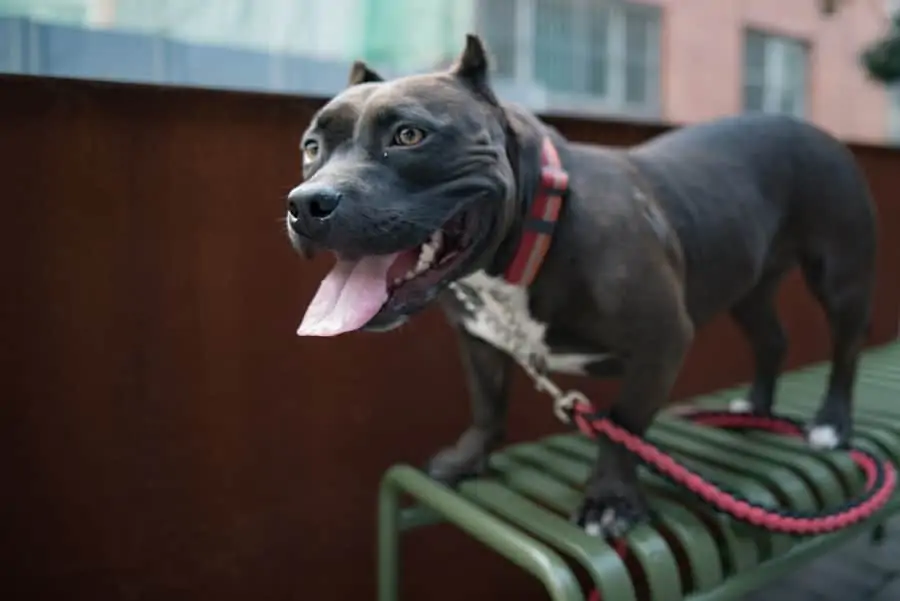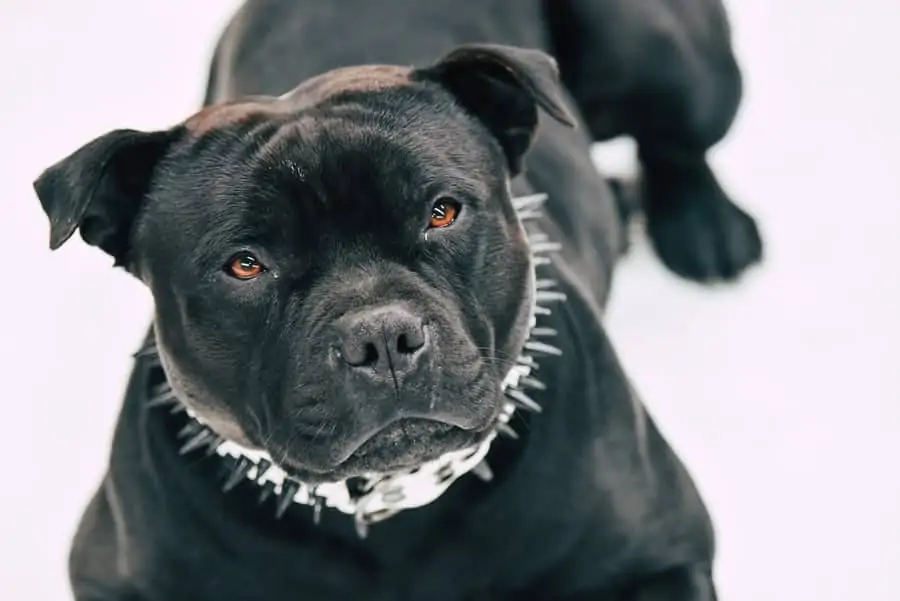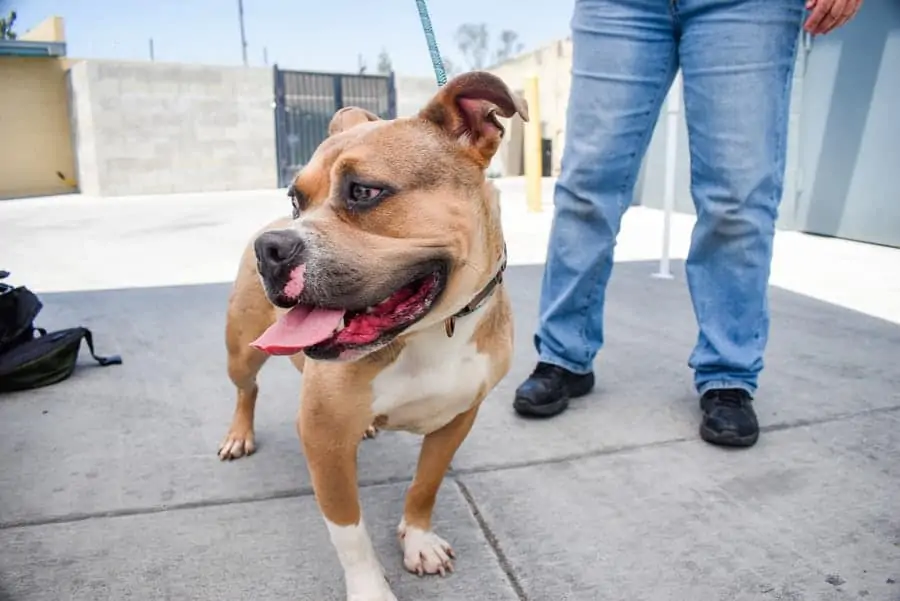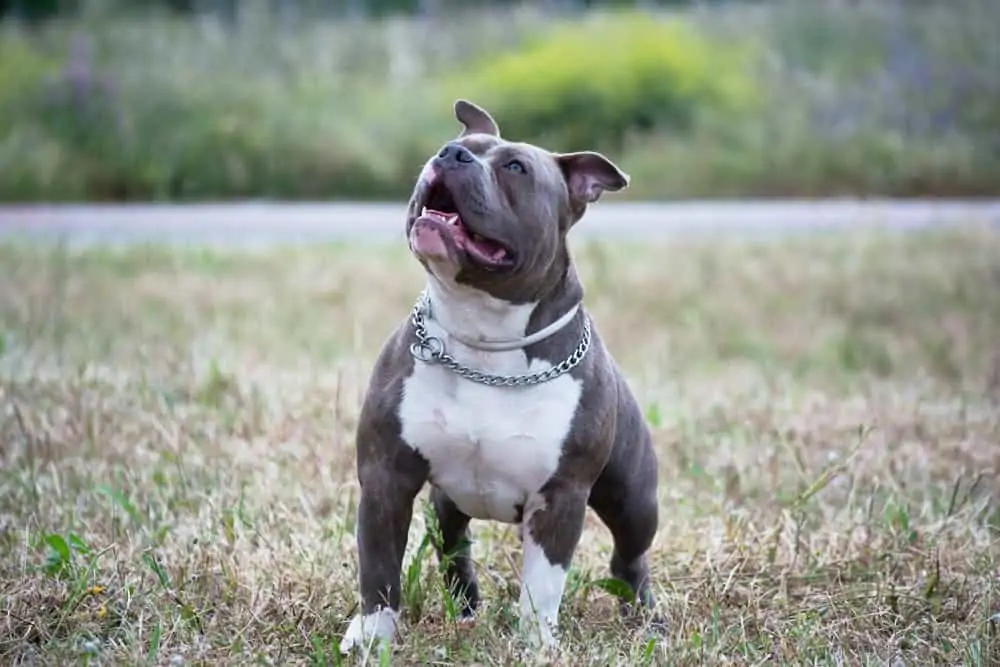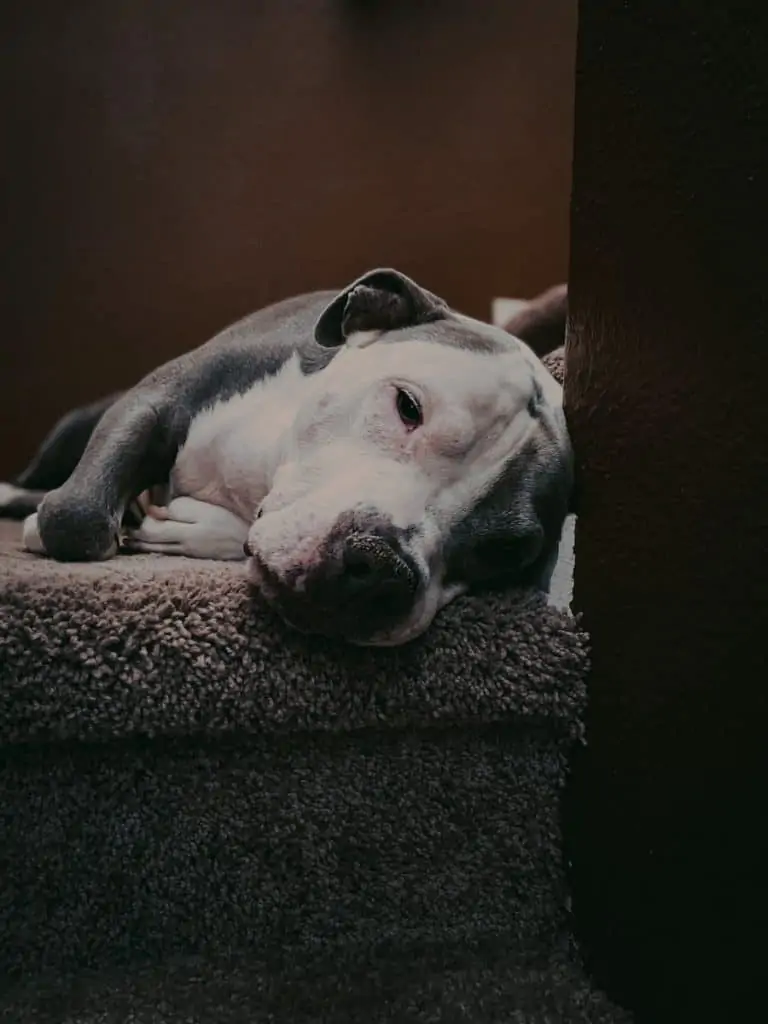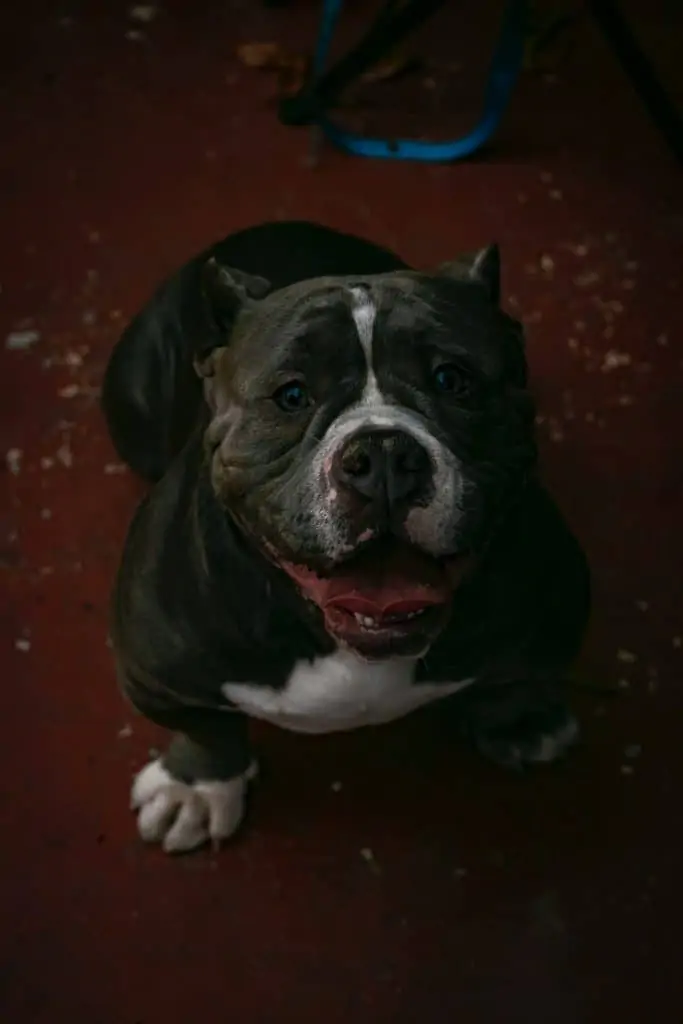The term “Pocket Pitbull” sounds like something dreamt up by the creators of Honey I Shrunk The Kids. In all actuality, however, this pint-sized pity really exists.
And he exists in just the way you might imagine. Pocket Pitbulls are, essentially, just bred down versions of their larger Pitbull counterparts. They are most often the offspring of the American Pitbull Terrier and the Patterdale Terrier.
They make ideal companions for owners who have a soft spot for Pitbulls but don’t have a lot of space in their home for the energetic and playful breed.
One of the great things about Pocket Pitbulls is that they often require less routine exercise, are cheaper to feed, and they may even be easier to maintain as far as grooming.
However, the Pocket Pitbull is also an energetic dog with a long history of baggage. Is this the right dog for you?
Let’s find out.
Contents
A Quick Overview Of The Pocket Pitbull
Also known as a Pocket Bully or Pocket Pit, the Pocket Pitbull is a bred down version of the American Pitbull Terrier amongst other breeds.
Pitbulls come in all shapes and sizes, and they also come in a variety of breeds. That’s right – a Pitbull is not one breed, but a term used to describe a variety of bully breeds. In the Pocket Pitbull’s case, he is a hybrid dog and is most often the bred down version of the American Pitbull Terrier and the Patterdale Terrier, as we mentioned above.
The American Pitbull Terrier
The average sized American Pitbull Terrier is between 17 to 20 inches and weighs around 30 to 65 pounds. This is one of the most common types of Pitbulls thought of when someone says the word Pitbull, and is also one of the few Pitbulls recognized by the American Kennel Club.
The Patterdale Terrier
Patterdale Terriers are smaller dogs with an average weight of 11 to 13 pounds and a height of no more than 12 inches.
Unlike the American Pitbull Terrier, the Patterdale Terrier is not yet recognized by the American Kennel Club. He is, however, recognized by the United Kennel Club and many other major breed clubs throughout the world.
The Pocket Pitbull – A Breed Overview
Height: 12 – 16 Inches
Weight: 11 – 22 Pounds
Coat Type: Smooth, shedding
Coat Colors: A wide variety of colors and patterns are available
Temperament: Affectionate, Devoted, Playful and Trainable
Health Issues: Hip dysplasia, allergies, skin and coat issues, cardiac disease, respiratory problems, eye issues, hypothyroidism, and food sensitivities.
Lifespan: 11 – 13 Years
Overview:
Also known as Pocket Bullys, Pocket Pits or Miniature Pitbulls, Pocket Pitbulls are not always super small. In general, they are more along the medium-sized dog range.
And, as we briefly mentioned, the Pocket Pitbull is not a purebred dog. Not only does this mean he is not eligible for show, but he is also not yet recognized by most major breed clubs in the United States.
Still, that doesn’t mean he’s any less spectacular than his purebred counterparts. In fact, crossbreeding has been a trend that has exploded in popularity over the past two decades, and there are plenty of benefits that come along with owning a crossbreed dog.
When it comes to the Pocket Pitbull, his compact size and big personality are just a few of those pros you should consider when considering investing in him.
Of course, it’s important to also consider the cons when it comes to a Pocket Pitbull. So, without further ado, let’s discuss your Pocket Pitbull’s origin, his bloody history, and why he and his ancestors have gotten such a bad rep.
An Overview Of The Pocket Pitbull Origin And History
Pitbulls come from a history of blood sports and bull baiting, which has led to generations of breed discrimination.
The Pocket Pitbull is a relatively newer crossbreed to the scene, which means we don’t really know all that much about him. It’s likely he was created over the last two decades, though it’s even more likely that breeding a Pitbull of this size and appearance was actually a mistake at first.
However, as society has proven, we like our dogs small. Pitbulls in general have a large fan base in spite of their shaky past, and it’s no surprise that breeders eventually used this to fuel their drive for creating smaller versions of one of the world’s most coveted dogs.
But just because we don’t know much about the Pocket Pitbull doesn’t mean we can’t learn more about him by digging into the histories of his parent breeds.
Let’s Begin With The Origin of The Pitbull:
Pitbulls were bred and perfected in 19th Century England. While they performed many working tasks and served as vermin dogs on farms, guard dogs, and even loyal companions, the Pitbull’s primary reason for existing was sadly to compete in blood sports.
The popularity of bull baiting and dog fighting led to breeders creating dogs with larger, stronger jaws, and many people to this day think that Pitbulls are excessively aggressive for this very reason.
The truth is, Pitbulls are actually no more aggressive than many other family-friendly breeds. In fact, they actually rank pretty low on the list of aggressive dogs, according to experts.
One of the traits that made Pitbulls so desirable during their fighting days was their incredible devotion to their humans. This meant they were (and still are) eager to please, easy to train, and willing to lay their life down for the people they love.
That said, there is still a risk associated with Pitbulls and even with the Pocket Pitbull around children and other pets. While all dogs can bite, the Pitbull’s bite is particularly damaging. So although the Pitbull is not the world’s most aggressive breed, he is still considered the world’s deadliest.
Luckily, routine training, socialization, and an experienced dog owner can drastically reduce the chances of a Pitbull bite, ensuring their Pitbull makes a wonderful, beloved companion to his family.
The Origin Of The Patterdale Terrier
The Patterdale Terrier could easily be mistaken for a small Labrador Retriever if you saw one with a smooth coat type. However, this dog is all terrier through and through. Bred in the rough climate of Northern England, Patterdale Terriers were working dogs designed to catch vermin and stop predators from accessing farmer’s sheep. Some of these dogs were even the sidekicks to poachers.
They are believed to be descendants of the Fell Terrier, and were not recognized by the United Kennel Club until january of 1995.
The Pocket Pitbull Controversy – What You Should Know
Though originally bred for blood sports, Pitbulls are generally known as gentle and loving dogs.
The Pocket Pitbull is undeniably cute. But, sadly, there is some controversy surrounding the breeding and selling of crossbreeds like the Pocket Pitbull in the United States. There is also controversy surrounding the continued breeding and selling of any Pitbull at all.
What You Should Know About the Crossbreed Controversy
Crossbreeding has been a practice that has been around since the very beginning of the human-canine relationship. In fact, most purebred dogs you know and love today are the result of careful breeding and perfecting by enthusiasts looking to combine certain qualities of working dogs.
Today, however, most of us don’t need working dogs anymore. Crossbreeding has become less about function and often more about fashion. Many crossbreeders breed and sell dogs based on looks, often swaying with trends of the time.
Does that mean crossbreeding breeders are bad? Of course not. As we mentioned, crossbreeding is an age old practice that has and always will be relevant when it comes to dogs.
However, there are some things you should consider when considering a crossbreed like the Pocket Pitbull. Typically, it takes generations of breeding and perfecting before a dog can be considered a purebred and given a predictable breed standard.
You should know that first and second generation crossbreeds are not going to be as predictable as third, fourth or fifth generation crossbreeds when it comes to appearance, temperament and even health.
However, there are those who stand firmly behind the idea of hybrid vigor, which is the notion that crossbreed dogs may actually be healthier than their purebred counterparts due to their more open gene pool.
Of course, it’s still important to note that all dogs can be susceptible to genetic health issues, regardless of their breeding stock. But we’ll talk more about your Pocket Pitbull’s health further down.
For now, let’s cover the controversy behind breeding and selling Pitbulls.
The Controversy Of Breeding and Selling Pitbulls
No, this controversy surrounding breeders selling Pitbull puppies is not due to the idea that Pitbulls are bad dogs that should cease to exist. It’s quite the opposite, actually. Sadly, Pitbulls are some of the most common dogs to be turned over to shelters. They are also often the first types of dogs to be put down when no one comes to adopt them.
Shelters are filled to the brim with this breed, and in the meantime breeders continue to saturate the market with new Pitbull puppies, leading to an overwhelming number of Pitbulls being put down every year.
When it comes to the Pocket Pitbull, however, there is a loophole. This dog is technically a crossbreed dog, and a newer one at that. It may be difficult to find a Pocket Pitbull at a shelter, but that doesn’t mean we wouldn’t encourage you to look, especially if it means you might be saving a dog’s life.
And with all that noted, it’s now time to talk about your Pocket Pitbull and his potential temperament, training requirements, exercise needs and more.
Let’s get to it!
The Pocket Pitbull Temperament and Personality Traits
When raised correctly, Pocket Pitbulls do well with children and people, though they may not get along well with other dogs.
Overall, Pocket Pitbulls are sweet, devoted, and intelligent companions. They become very bonded with their people and are great additions to homes with children or active couples and singles.
They are friendly with people and playful to boot. However, they may not get along well with other dogs, especially if they are not properly trained and socialized at an early age.
If you plan on raising your Pocket Pitbull with children, experts recommend working with age-appropriate kids on the proper and respectful ways to interact with the family dog. You should also be sure to monitor very young children around your Pocket Pitbull to ensure they are not being too handsy and that everyone is getting along safely.
When raising any dog, it’s not a bad idea to sit down with your whole family and learn a bit about basic canine body language.
Working to better understand how your Pocket Pitbull communicates will not only help reduce the chances of a bite, but it can also help strengthen the bond between you, your family and your dog.
That noted, most Pocket Pitbull dogs will do well in just about any home environment. They are relatively quiet, clean and go-with-the-flow hybrid dogs who require moderate exercise.
They can become destructive, however, especially if they are left to become bored. For this reason, the Pocket Pitbull is a great candidate for crate training, especially if you have a busy schedule or are gone often during the day.
Midwest Home Dog Crate
No products found.
The Midwest Home Dog Crate above is a basic dog crate that is ideal for the Pocket Pitbull. You can order it with a divider to help puppies feel more comfortable, and remove that divider as your Pocket Pitbull ages.
These crates are also available in different sizes, so you can get one that fits your smaller Pocket Pitbull perfectly. We also suggest you consider ordering crate pads to help make your dog’s crate comfy, and perhaps even a crate cover to help reduce potential anxiety.
Tips On Training and Socializing A Pocket Pitbull
It’s never too early to begin training your Pitbull puppy.
Socialization and training are an important part of being a responsible pet parent, especially when it comes to a dog like the Pocket Pitbull. Though smaller than most other Pitbull dogs, the Pocket Pitbull can still develop serious behavioral issues if his emotional and physical needs are not met.
How To Properly Socialize Your Pocket Pitbull
Like people, dogs can develop anxiety and trauma responses to situations that have caused them fear or pain in the past. Unlike people, traumatic situations can be as small as stepping on your dog’s paw during his “fear-period” which is between the ages of 6 and 14 months.
The fear period of a dog’s life is a time when he is most actively discovering the world and making connections about what is safe and what is not safe around him. Any connections made during this time will stay with your dog for the rest of his life and can make the difference between a confident, well-adjusted dog and a fearful, aggressive dog.
Since most puppies make their way into their forever home between seven and eight months, it’s often the owners responsibility to help reduce fears and build a happy, confident dog.
To do this, you’ll need to implement proper socialization. Properly socializing your Pocket Pitbull will include bringing him with you on as many outings as possible at a young age. Introduce him to as many different people, animals, sights, sounds, places, things and experiences as you can, and try and help him find these experiences positive.
Of course, you are not always in control of what your Pocket Pitbull finds to be scary vs not scary, so it’s also equally important to refrain from forcing your dog into a situation that he is obviously hesitant about.
Forcing any dog into a situation that frightens him could actually exasperate fears, reduce the effectiveness of socialization, and lead to future behavioral problems.
How To Properly Train Your Pocket Pitbull
Socializing and training your dog go hand and hand, and often the two can be utilized together throughout the day. It’s never too early to begin working with your Pocket Pitbull when it comes to training, and he’s never too young or too old to learn.
Begin by teaching your Pocket Pitbull basic cues like sit, stay, and lie down. And don’t forget the most important cue of all – come. Building a solid recall with your Pocket Pitbull is essential to his future safety.
With that in mind, it’s best to refrain from punishing your Pocket Pitbull during training sessions. Punishment has been found to actually hinder a dog’s ability to learn and can even lead to a corrosion in the owner-dog bond.
Contrarily, studies have found that dogs actually respond best to positive reinforcement training that utilizes treats and praise.
That said, the Pocket Pitbull can become stubborn and bored with dull training sessions, even if you use high quality treats and lots of encouraging praise. Remember, he is a mix between a Pitbull and a Terrier, so you’ll have to keep your enthusiasm level at a 10 during training to keep your dog engaged.
We also suggest you keep sessions no longer than five minutes at a time and take plenty of breaks in between sessions.
Merrick Power Bites Training Treats
No products found.
Investing in healthy training treats for your Pocket Pitbull can make all the difference in how a training session goes. High value treats will help reduce distractions, keep your dog’s focus, and can even help increase the bond between the two of you.
We like Merrick treats for Pitbulls because they are made with high quality ingredients, are gluten free, and are made with real meat protein. Best of all, they are soft, chewy and highly palatable, so your Pocket Pitbull is sure to love them.
Exercise And Mental Stimulation – Keeping Your Pocket Pitbull Healthy and Happy
Though smaller than most of his Pitbull counterparts, the Pocket Pitbull still requires routine exercise and mental stimulation.
Though small, the Pocket Pitbull is still going to require routine exercise and mental stimulation each and every day.
If this dog’s exercise needs and emotional needs are not met, he can be prone to developing some serious behavioral issues, as we mentioned above.
On average, the Pocket Pitbull will do well with an hour or so of exercise each day. The best exercise would be a good walk, a hike, or even a long game of fetch in a securely fenced yard.
Pocket Pitbulls are smaller dogs, which means they can be more prone to tracheal collapse. And, because they are bully breeds, they may also struggle with heat intolerance and have respiratory issues.
For this reason amongst many others, it’s best to steer clear of prong collars, choke chains and shock collars when it comes to the Pocket PItbull. Instead, utilize walking equipment that is safe and functional, like front clip harnesses, head harnesses, or Freedom Harnesses.
The PetSafe Easy Walk Front Clip Harness
No products found.
The PetSafe Easy Walk Harness is a harness we recommend for the Pocket Pitbull. This is a front clip harness that is designed to fit snugly on your dog to make walking feel more natural for him and for you.
Better still, the PetSafe Easy Walk Harness reduces pulling. It works by redirecting your Pocket Pitbull back to you without putting too much pressure on his chest or throat. It also doesn’t pull against his back or neck when he’s walking, which further reduces your dog’s natural urge to pull at all.
Along with routine exercise, the Pocket Pitbull will also need to be kept mentally stimulated. Working with your dog on consistent training can help keep him mentally sound, but we also suggest you invest in interactive toys like puzzle toys and KONGS to help keep him busy throughout the day.
The Classic KONG
No products found.
Chances are you know about the KONG. This diverse dog toy is so much more than just a chew. It can actually help reduce boredom in your dog, encourage healthy eating habits, reduce behavioral issues like chewing and digging, and even keep your dog engaged for a long period of time while you’re busy or away.
KONGS bring a sense of comfort to dogs, who have a natural urge to chew. They are also a safe way for dogs to release pent up anxiety from the day.
How To Groom Your Pocket Pitbull
Grooming is relatively easy, though Pocket Pitbulls can suffer from dry skin and allergies.
If you’re looking for a low maintenance dog when it comes to grooming, you’ll be in heaven with the Pocket Pitbull. This is a hybrid who, while shedding, doesn’t shed heavily and only requires some routine maintenance when it comes to his coat.
Investing in some quality dog brushes or a shedding comb can help reduce loose fur, and it can also help keep your Pocket Pitbull’s skin and coat healthy. You should only need to brush your Pocket Pitbull once or twice a week. However, during the shedding season in spring and fall, you may want to brush him a bit more often.
Along with occasional brushing, the Pocket Pitbull will also need a bath once in a while. It’s important not to overbathe this dog, as he can be prone to developing skin issues and allergies that can be exasperated by too much washing.
Instead, stick with bathing your Pocket Pitbull once every month or two months, and be sure to use a quality shampoo that is designed to be used on dogs with sensitivities.
A hypoallergenic shampoo and a shampoo that will not strip your Pocket Pitbull of his skin’s natural oils will be best.
Your Pocket Pitbull should also have his nails trimmed or ground down often. This will help keep them from breaking or cracking, which can lead to pain and even infections.
Keeping your dog’s ears cleaned will help keep ear infections at bay and ensuring you brush your Pocket Pitbulls teeth with a toothbrush and dog-safe toothpaste at least once a day can help manage dental issues as your dog ages.
The Pocket Pitbull Health Issues and Life Expectancy
Pocket Pitbulls can suffer from some serious health issues, especially if they come from irresponsible sources.
Pocket Pitbulls can live between 11 and 13 years, though it’s not uncommon for some to live longer. However, like all dogs, the Pocket Pitbull can be prone to suffering from some serious genetic health issues owners should be aware of.
These issues include:
- Numerous Eye Problems
- Hip Dysplasia
- Skin and Coat Issues
- Allergies
- Food Sensitivities
- Respiratory Problems
- Hypothyroidism
- And Cardiac Issues
You can help your Pocket Pitbull live his healthiest life by making sure you get him from a reputable breeder or shelter and by ensuring you keep him on a quality diet. This is a breed that will do best on a high protein dog food specified for his age, weight and activity level.
This dog food should include healthy ingredients like carbs, fatty acids, real mean protein, vitamins and minerals. Be sure to avoid dog foods that are loaded with artificial ingredients, fillers, additives and by-products.
Blue Buffalo High Protein Dog Food With Salmon
No products found.
We recommend Blue Buffalo High Protein Dog Food with Salmon for the Pocket Pitbull because it is rich in high quality ingredients and contains real animal protein. Furthermore, it is free of poultry, which can exasperate certain skin issues and allergies in sensitive dogs.
This dog food is also ideal for the Pocket Pitbull because it contains fish, which means it is loaded with DHA to support a healthy skin and coat.
Is The Pocket Pitbull Right For You? Let’s Find Out!
The Pocket Pitbull makes a wonderful companion for the right owner.
The Pocket Pitbull is so much more than a cute name. He is an intelligent, affectionate, devoted creature who requires plenty of time, attention, care and love. Do you think this is the right dog for you?
Remember, while Pocket Pitbulls do get along well with children and most people, they can be wary of dogs and other animals. This is especially true if your Pocket Pitbull isn’t properly trained and socialized.
And while they’re smaller than their other Pitbull counterparts, Pocket Pitbulls will do well in homes with backyards where they can run and play freely. They will also enjoy homes with owners that are around often, and owners who have the time to commit to training and exercise.
So, do you think you’re the ideal owner for a Pocket PItbull? Tell us what you think about this cute bully mix in the comment section below.
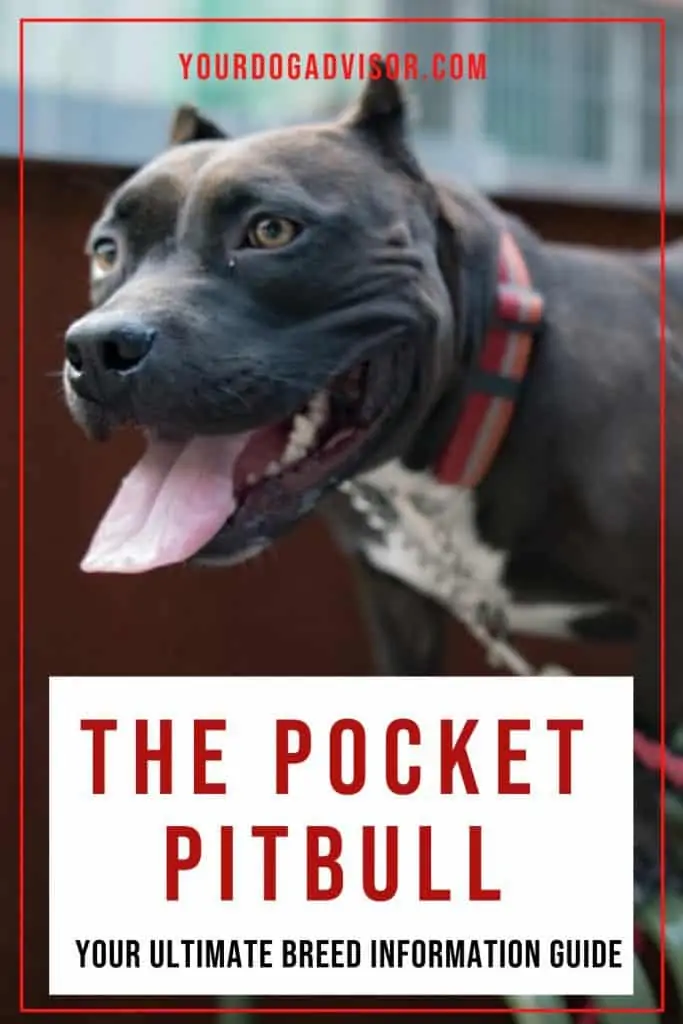

Jen Jones is a professional dog trainer and behavior specialist with more than 25 years of experience. As the founder of ‘Your Dog Advisor’ and the ‘Canine Connection’ rehabilitation center, she applies a holistic, empathetic approach, aiming to address root causes rather than merely treating symptoms.
Well known for her intuitive and compassionate approach, Jen adopts scientifically-proven, reward-based methods, encouraging positive reinforcement over punishment. Jen specializes in obedience training, behavior modification, and puppy socialization. Her innovative methods, particularly in addressing anxiety and aggression issues, have been widely recognized. Jen has worked with many of the world’s leading dog behaviorists and in her free time volunteers with local animal shelters and rescue groups.

